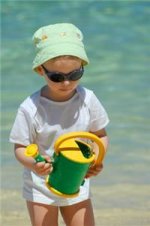
Finally summer is here – and with it the urge to let your little ones dash about in the sun with carefree abandon.
But before you set them off on their rampages on the beach, in the park or simply in the garden, experts warn it’s important to take precautions to keep them safe in this heat.
From the sun’s impact on sensitive young skin to the danger of bright UV rays for their eyes, there are key steps you should take to prep your little ones first.
Avoid the midday sun
That “Mad dogs and Englishmen” ditty may be a cliché but it’s true – the midday sun is the most lethal when it comes to skin damage and burning. In fact, the two hours before and after midday (from 10am to 2pm) are when the sun’s rays are at their strongest. Where possible keep your little ones out of direct sunlight and in the shade at these times. Head out early for a dose of Vitamin D or in the late afternoon for a balmier experience instead.
Slap on the sunscreen
A child’s skin is thinner and more sensitive than an adult’s so it burns far more easily. Research shows that just six episodes of serious sunburn before the age of 18 doubles the risk of developing skin cancer as an adult.
Buy a waterproof high factor children’s sunscreen (upwards of factor 15) and apply it half an hour before going outside to allow it to sink in. Then reapply regularly – that is, every two hours, and after swimming.
The NHS advises choosing a “broad spectrum brand” that has a four or five star rating. Apply it to all exposed areas – including face, neck, ears, feet and backs of hands.
For children prone to eczema there are certain brands specially formulated for more sensitive skins. Test any new sunscreen on a small area of skin and wait for up to 48 hours to see if there is any reaction. Apply your child’s moisturiser and, if necessary, steroids first and the sun cream 30 minutes later.
Pop on a UV suit
Children are impossible to keep in one place, so if you want to ensure the best protection for their skin as they dash about in the sun, invest in a UV protective sun suit or swim suit. Alternatively, choose cool, light-coloured clothes in cotton or linen to keep them from overheating.
Choose your hat carefully
A baseball cap may shade the eyes but it’s no good for sensitive areas such as the back of the neck. Choose a wide brimmed variety or, ideally, a ‘legionnaire’ style cap that has flaps over the neck and ears.
Wear shades
It’s more than just a baby fashion fad: wearing sunglasses in the bright sunlight provides vital protection for your child’s eyes. Exposure to intense UV light can cause damage, including cataracts.
Use 100 per cent UV-blocking sunglasses with wrap-around protection that stop the sun from getting in at the sides. Never use toy sunglasses: instead, look for the sticker on the lenses that tells you that the sunglasses provide proper UV protection. The Royal College of Ophthalmologists recommends those that adhere to the UV400 industry standard.
Don’t be fooled by the cloud
Remember that skin can burn even on cloudy days so take all the same precautions. Even when it is overcast, up to 50 per cent of solar UV radiation can get through.
And if travelling for long periods in the sun in a car do use a UV sunshade to protect your children. Look for ones that actually block UV rays rather than a loosely woven shade that will simply cut down glare.
Water, water, water
Children will be so caught up in playing, whether building sandcastles, splashing in the sea or zooming down waterslides that they won’t think to stop and drink. Offer them plenty of water regularly to avoid dehydration.
If you are breastfeeding make sure you drink plenty of fluids, too. You won’t need to give a breastfed baby water but you may want to breastfeed them a little more than usual. If you are bottle feeding, as well as their usual milk feeds, you can give your baby cooled boiled water throughout the day. If your baby wakes at night, they’ll probably want milk but if they’ve had their usual milk feeds, try cooled boiled water as well.
Very diluted fruit juices, ice cubes and homemade fruit juice lollies throughout the day can also help keep hydration levels up for younger children, and make sure older ones have plenty of fruit and salad.
Regular breaks
No matter how protected your little one is in the sun, prolonged exposure to heat can still cause heat stroke – so on hot days make sure your tot takes regular breaks from the sun. A nap in the shade or a visit indoors for lunch is a good idea.
Attach a parasol to the pram
When out in the sun with young babies buy a parasol to attach to the pram or pushchair to keep them in the shade at all times.
Stay cool at night
When temperatures soar don’t be tempted to tuck your baby or toddler up in his or her usual bedding. Going to sleep in just a nappy is fine and will ensure they don’t get overheated during the night.
Consider hanging a wet towel from a chair or airer in front of an open window near their cot or bed – this helps release cooler air into the atmosphere. A lukewarm bath before bed may also help, and keep bedrooms fresh during the day by keeping blinds or curtains closed and windows open.
Yahoo Lifestyle
No comments:
Post a Comment